The Obesity Epidemic in Australia: A Public Health Report
VerifiedAdded on 2022/11/13
|5
|974
|283
Report
AI Summary
This report provides an overview of the obesity epidemic in Australia, highlighting its prevalence, particularly among adults. It discusses the health risks associated with obesity, including diabetes, hypertension, and heart infections. The report emphasizes the Australian Institute of Health and Welfare's perspective on addressing obesity from a young age, citing childhood and adolescent stages as critical periods. It defines obesity based on Body Mass Index (BMI) and explores various contributing factors such as dietary preferences, genetic background, increased fast food consumption, reduced physical activity, and psychological factors. Furthermore, the report references studies on breastfeeding and provides recommendations for parents and stakeholders to promote balanced diets, physical activity, and reduced screen time among children and young people.
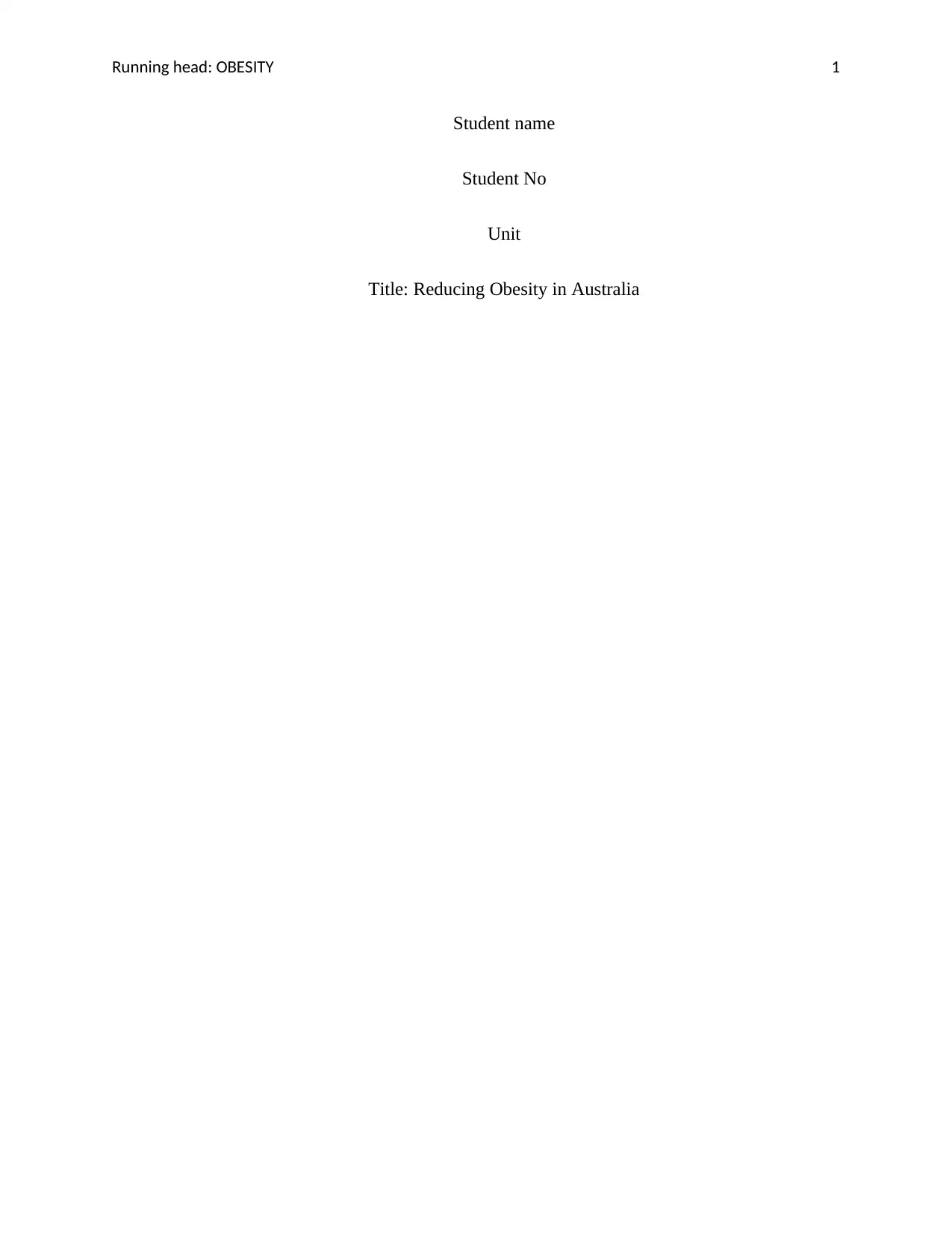
Running head: OBESITY 1
Student name
Student No
Unit
Title: Reducing Obesity in Australia
Student name
Student No
Unit
Title: Reducing Obesity in Australia
Paraphrase This Document
Need a fresh take? Get an instant paraphrase of this document with our AI Paraphraser
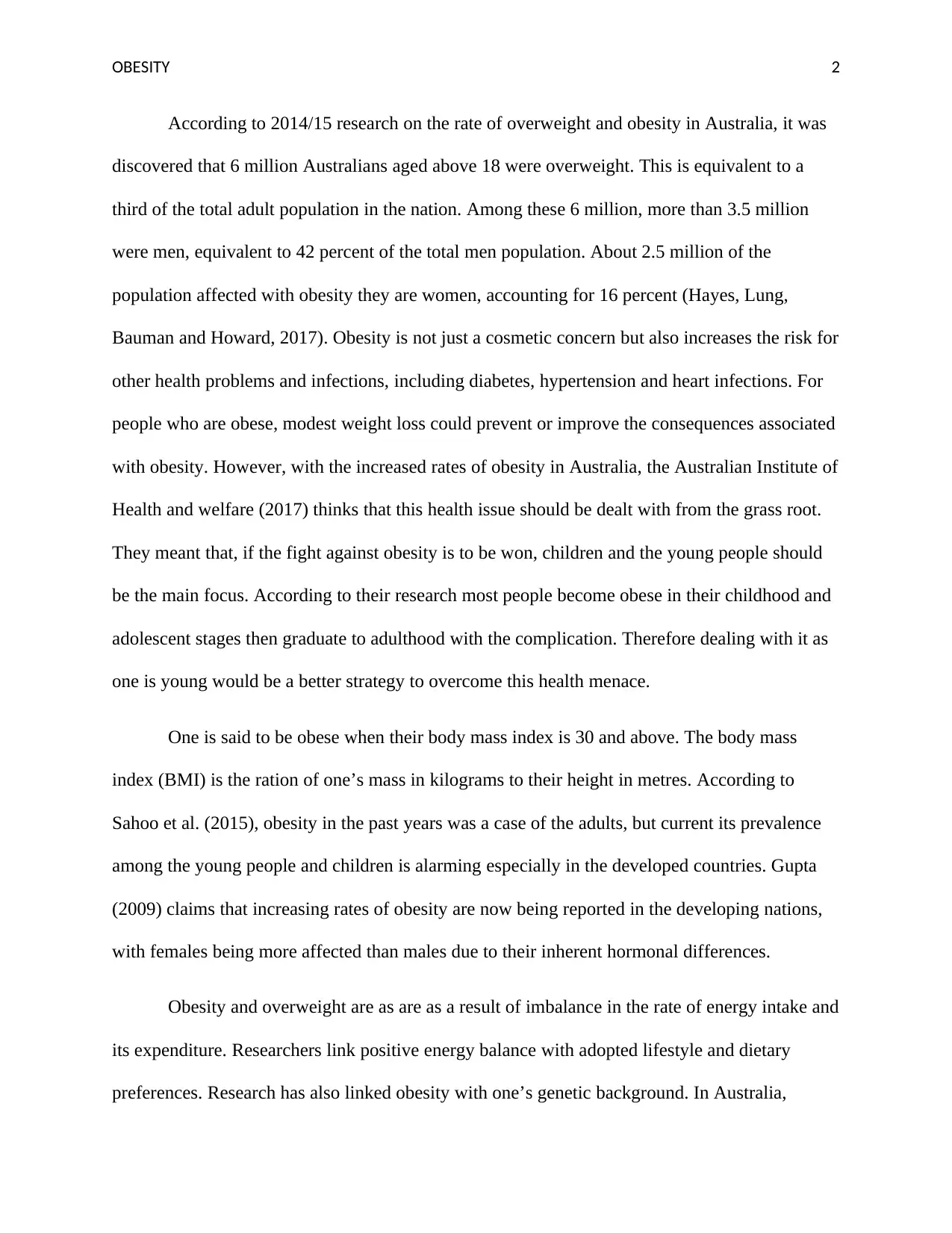
OBESITY 2
According to 2014/15 research on the rate of overweight and obesity in Australia, it was
discovered that 6 million Australians aged above 18 were overweight. This is equivalent to a
third of the total adult population in the nation. Among these 6 million, more than 3.5 million
were men, equivalent to 42 percent of the total men population. About 2.5 million of the
population affected with obesity they are women, accounting for 16 percent (Hayes, Lung,
Bauman and Howard, 2017). Obesity is not just a cosmetic concern but also increases the risk for
other health problems and infections, including diabetes, hypertension and heart infections. For
people who are obese, modest weight loss could prevent or improve the consequences associated
with obesity. However, with the increased rates of obesity in Australia, the Australian Institute of
Health and welfare (2017) thinks that this health issue should be dealt with from the grass root.
They meant that, if the fight against obesity is to be won, children and the young people should
be the main focus. According to their research most people become obese in their childhood and
adolescent stages then graduate to adulthood with the complication. Therefore dealing with it as
one is young would be a better strategy to overcome this health menace.
One is said to be obese when their body mass index is 30 and above. The body mass
index (BMI) is the ration of one’s mass in kilograms to their height in metres. According to
Sahoo et al. (2015), obesity in the past years was a case of the adults, but current its prevalence
among the young people and children is alarming especially in the developed countries. Gupta
(2009) claims that increasing rates of obesity are now being reported in the developing nations,
with females being more affected than males due to their inherent hormonal differences.
Obesity and overweight are as are as a result of imbalance in the rate of energy intake and
its expenditure. Researchers link positive energy balance with adopted lifestyle and dietary
preferences. Research has also linked obesity with one’s genetic background. In Australia,
According to 2014/15 research on the rate of overweight and obesity in Australia, it was
discovered that 6 million Australians aged above 18 were overweight. This is equivalent to a
third of the total adult population in the nation. Among these 6 million, more than 3.5 million
were men, equivalent to 42 percent of the total men population. About 2.5 million of the
population affected with obesity they are women, accounting for 16 percent (Hayes, Lung,
Bauman and Howard, 2017). Obesity is not just a cosmetic concern but also increases the risk for
other health problems and infections, including diabetes, hypertension and heart infections. For
people who are obese, modest weight loss could prevent or improve the consequences associated
with obesity. However, with the increased rates of obesity in Australia, the Australian Institute of
Health and welfare (2017) thinks that this health issue should be dealt with from the grass root.
They meant that, if the fight against obesity is to be won, children and the young people should
be the main focus. According to their research most people become obese in their childhood and
adolescent stages then graduate to adulthood with the complication. Therefore dealing with it as
one is young would be a better strategy to overcome this health menace.
One is said to be obese when their body mass index is 30 and above. The body mass
index (BMI) is the ration of one’s mass in kilograms to their height in metres. According to
Sahoo et al. (2015), obesity in the past years was a case of the adults, but current its prevalence
among the young people and children is alarming especially in the developed countries. Gupta
(2009) claims that increasing rates of obesity are now being reported in the developing nations,
with females being more affected than males due to their inherent hormonal differences.
Obesity and overweight are as are as a result of imbalance in the rate of energy intake and
its expenditure. Researchers link positive energy balance with adopted lifestyle and dietary
preferences. Research has also linked obesity with one’s genetic background. In Australia,
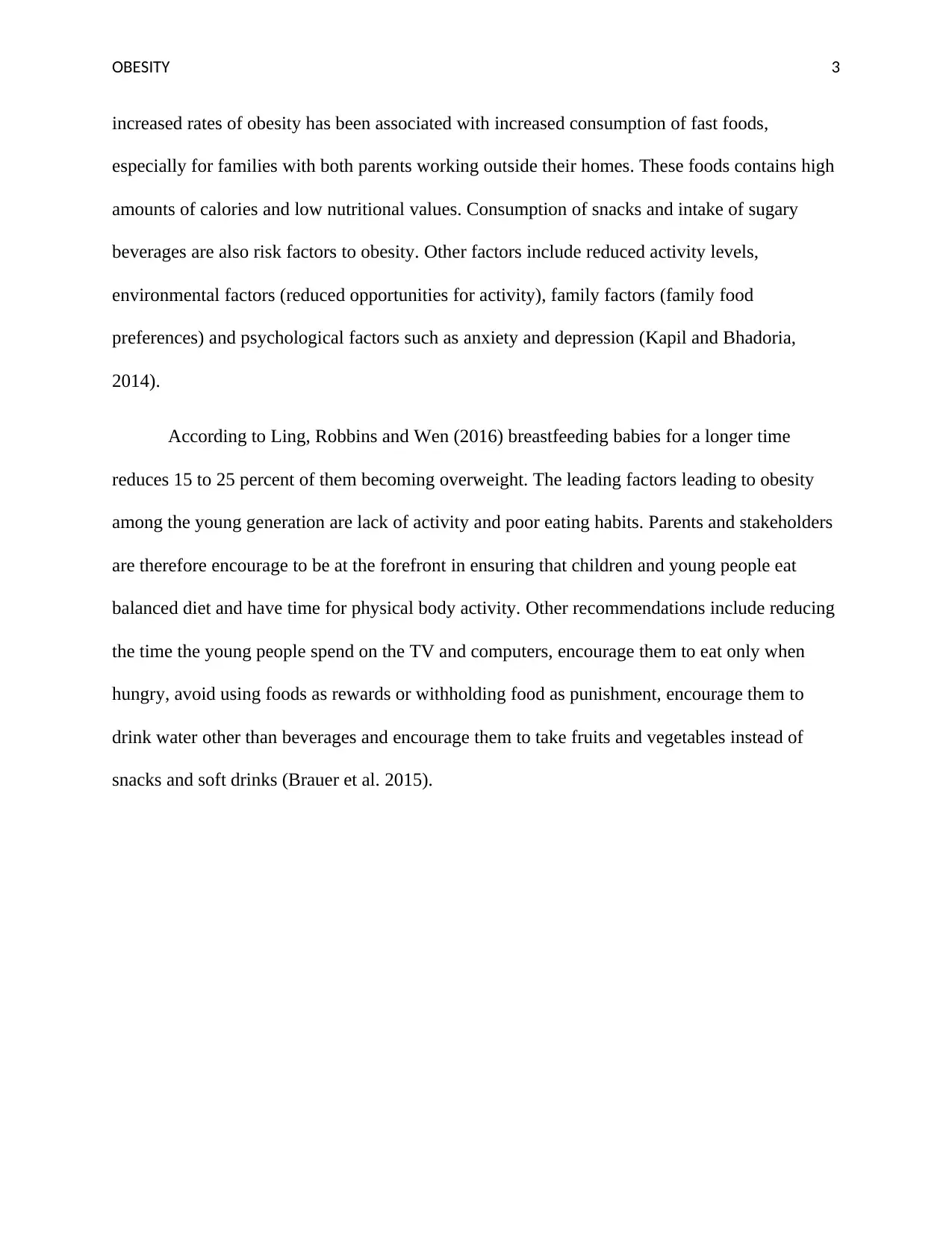
OBESITY 3
increased rates of obesity has been associated with increased consumption of fast foods,
especially for families with both parents working outside their homes. These foods contains high
amounts of calories and low nutritional values. Consumption of snacks and intake of sugary
beverages are also risk factors to obesity. Other factors include reduced activity levels,
environmental factors (reduced opportunities for activity), family factors (family food
preferences) and psychological factors such as anxiety and depression (Kapil and Bhadoria,
2014).
According to Ling, Robbins and Wen (2016) breastfeeding babies for a longer time
reduces 15 to 25 percent of them becoming overweight. The leading factors leading to obesity
among the young generation are lack of activity and poor eating habits. Parents and stakeholders
are therefore encourage to be at the forefront in ensuring that children and young people eat
balanced diet and have time for physical body activity. Other recommendations include reducing
the time the young people spend on the TV and computers, encourage them to eat only when
hungry, avoid using foods as rewards or withholding food as punishment, encourage them to
drink water other than beverages and encourage them to take fruits and vegetables instead of
snacks and soft drinks (Brauer et al. 2015).
increased rates of obesity has been associated with increased consumption of fast foods,
especially for families with both parents working outside their homes. These foods contains high
amounts of calories and low nutritional values. Consumption of snacks and intake of sugary
beverages are also risk factors to obesity. Other factors include reduced activity levels,
environmental factors (reduced opportunities for activity), family factors (family food
preferences) and psychological factors such as anxiety and depression (Kapil and Bhadoria,
2014).
According to Ling, Robbins and Wen (2016) breastfeeding babies for a longer time
reduces 15 to 25 percent of them becoming overweight. The leading factors leading to obesity
among the young generation are lack of activity and poor eating habits. Parents and stakeholders
are therefore encourage to be at the forefront in ensuring that children and young people eat
balanced diet and have time for physical body activity. Other recommendations include reducing
the time the young people spend on the TV and computers, encourage them to eat only when
hungry, avoid using foods as rewards or withholding food as punishment, encourage them to
drink water other than beverages and encourage them to take fruits and vegetables instead of
snacks and soft drinks (Brauer et al. 2015).
⊘ This is a preview!⊘
Do you want full access?
Subscribe today to unlock all pages.

Trusted by 1+ million students worldwide
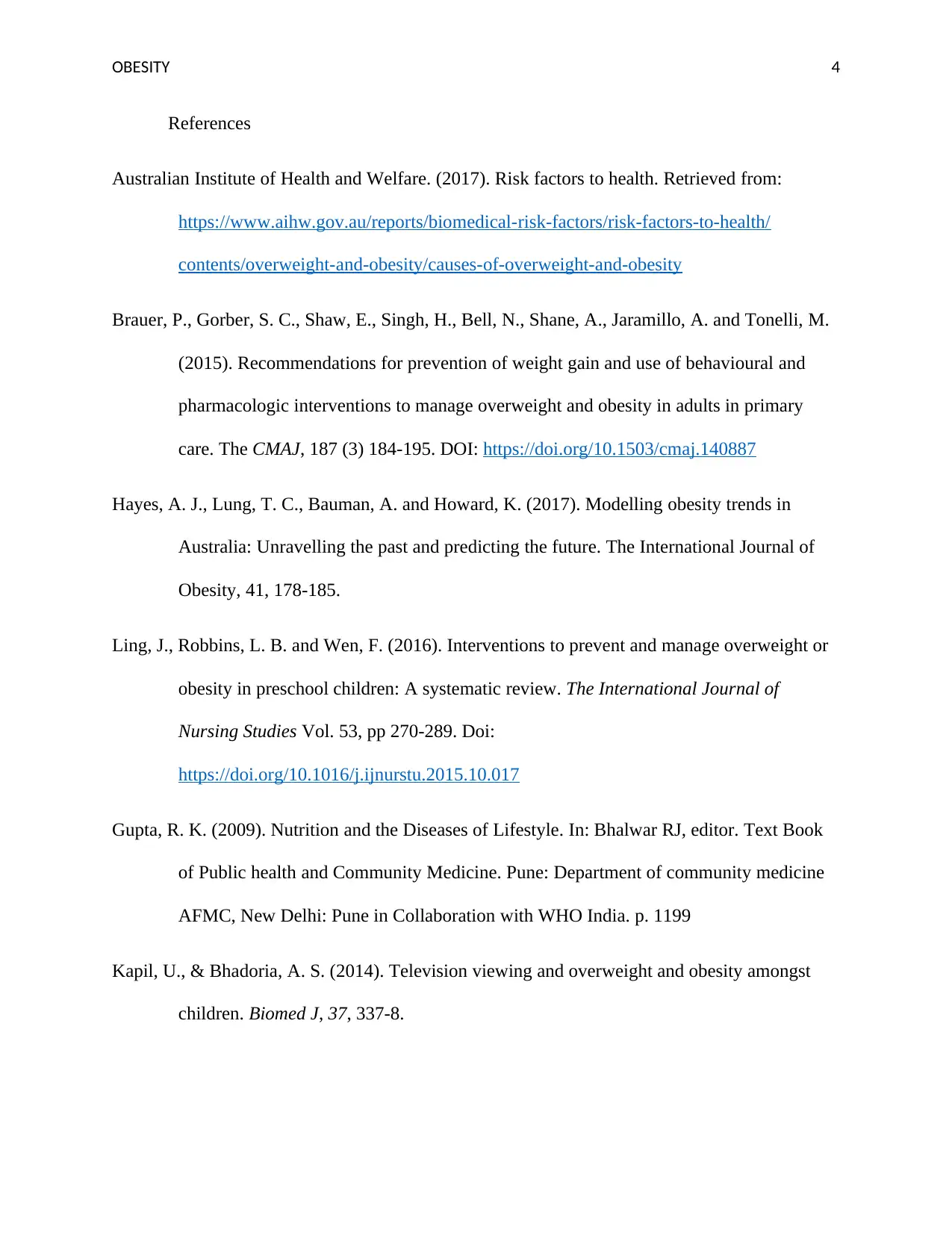
OBESITY 4
References
Australian Institute of Health and Welfare. (2017). Risk factors to health. Retrieved from:
https://www.aihw.gov.au/reports/biomedical-risk-factors/risk-factors-to-health/
contents/overweight-and-obesity/causes-of-overweight-and-obesity
Brauer, P., Gorber, S. C., Shaw, E., Singh, H., Bell, N., Shane, A., Jaramillo, A. and Tonelli, M.
(2015). Recommendations for prevention of weight gain and use of behavioural and
pharmacologic interventions to manage overweight and obesity in adults in primary
care. The CMAJ, 187 (3) 184-195. DOI: https://doi.org/10.1503/cmaj.140887
Hayes, A. J., Lung, T. C., Bauman, A. and Howard, K. (2017). Modelling obesity trends in
Australia: Unravelling the past and predicting the future. The International Journal of
Obesity, 41, 178-185.
Ling, J., Robbins, L. B. and Wen, F. (2016). Interventions to prevent and manage overweight or
obesity in preschool children: A systematic review. The International Journal of
Nursing Studies Vol. 53, pp 270-289. Doi:
https://doi.org/10.1016/j.ijnurstu.2015.10.017
Gupta, R. K. (2009). Nutrition and the Diseases of Lifestyle. In: Bhalwar RJ, editor. Text Book
of Public health and Community Medicine. Pune: Department of community medicine
AFMC, New Delhi: Pune in Collaboration with WHO India. p. 1199
Kapil, U., & Bhadoria, A. S. (2014). Television viewing and overweight and obesity amongst
children. Biomed J, 37, 337-8.
References
Australian Institute of Health and Welfare. (2017). Risk factors to health. Retrieved from:
https://www.aihw.gov.au/reports/biomedical-risk-factors/risk-factors-to-health/
contents/overweight-and-obesity/causes-of-overweight-and-obesity
Brauer, P., Gorber, S. C., Shaw, E., Singh, H., Bell, N., Shane, A., Jaramillo, A. and Tonelli, M.
(2015). Recommendations for prevention of weight gain and use of behavioural and
pharmacologic interventions to manage overweight and obesity in adults in primary
care. The CMAJ, 187 (3) 184-195. DOI: https://doi.org/10.1503/cmaj.140887
Hayes, A. J., Lung, T. C., Bauman, A. and Howard, K. (2017). Modelling obesity trends in
Australia: Unravelling the past and predicting the future. The International Journal of
Obesity, 41, 178-185.
Ling, J., Robbins, L. B. and Wen, F. (2016). Interventions to prevent and manage overweight or
obesity in preschool children: A systematic review. The International Journal of
Nursing Studies Vol. 53, pp 270-289. Doi:
https://doi.org/10.1016/j.ijnurstu.2015.10.017
Gupta, R. K. (2009). Nutrition and the Diseases of Lifestyle. In: Bhalwar RJ, editor. Text Book
of Public health and Community Medicine. Pune: Department of community medicine
AFMC, New Delhi: Pune in Collaboration with WHO India. p. 1199
Kapil, U., & Bhadoria, A. S. (2014). Television viewing and overweight and obesity amongst
children. Biomed J, 37, 337-8.
Paraphrase This Document
Need a fresh take? Get an instant paraphrase of this document with our AI Paraphraser
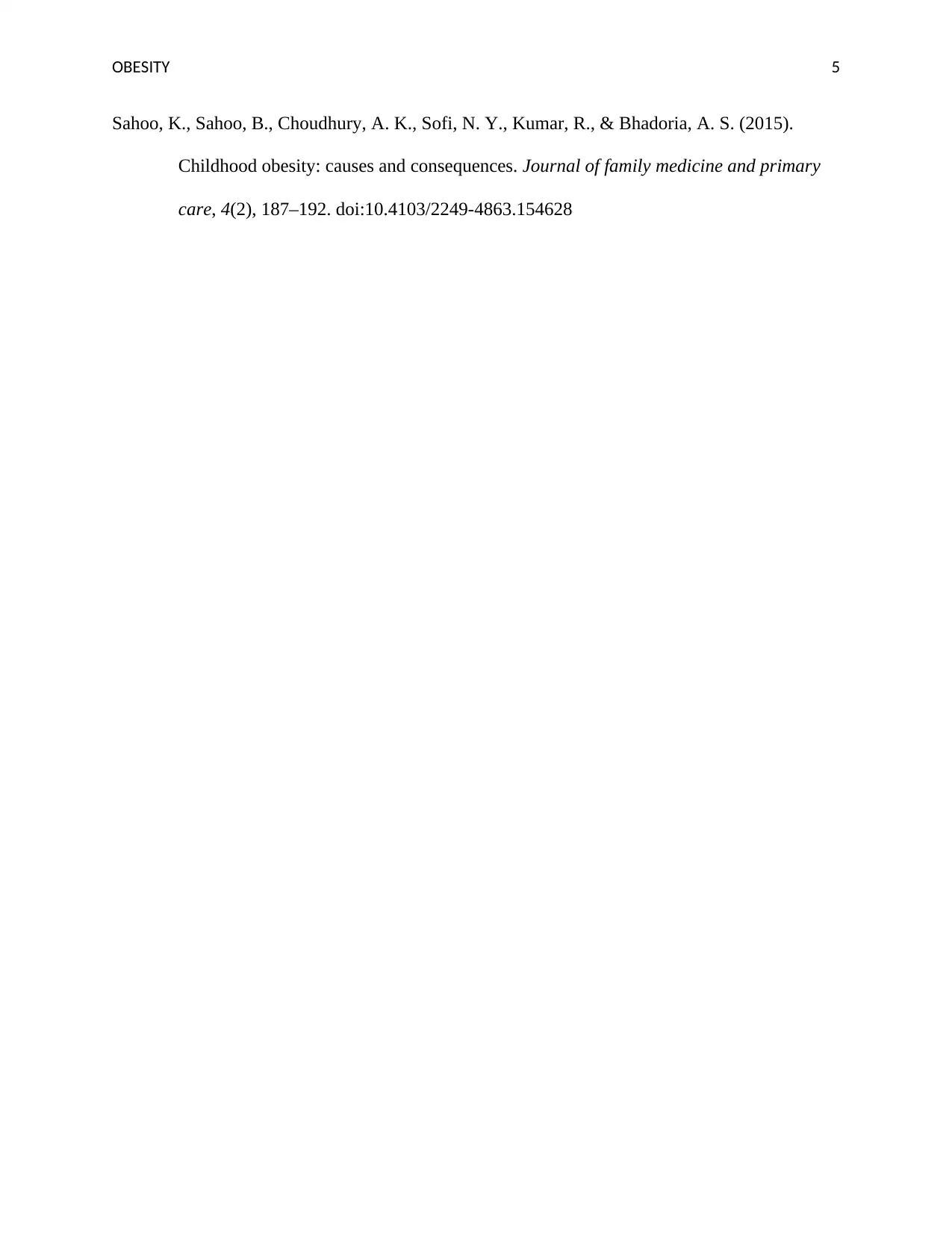
OBESITY 5
Sahoo, K., Sahoo, B., Choudhury, A. K., Sofi, N. Y., Kumar, R., & Bhadoria, A. S. (2015).
Childhood obesity: causes and consequences. Journal of family medicine and primary
care, 4(2), 187–192. doi:10.4103/2249-4863.154628
Sahoo, K., Sahoo, B., Choudhury, A. K., Sofi, N. Y., Kumar, R., & Bhadoria, A. S. (2015).
Childhood obesity: causes and consequences. Journal of family medicine and primary
care, 4(2), 187–192. doi:10.4103/2249-4863.154628
1 out of 5
Related Documents
Your All-in-One AI-Powered Toolkit for Academic Success.
+13062052269
info@desklib.com
Available 24*7 on WhatsApp / Email
![[object Object]](/_next/static/media/star-bottom.7253800d.svg)
Unlock your academic potential
Copyright © 2020–2025 A2Z Services. All Rights Reserved. Developed and managed by ZUCOL.




